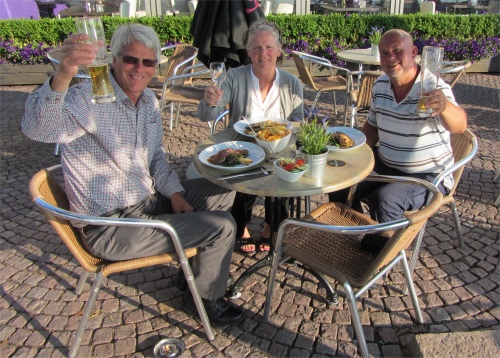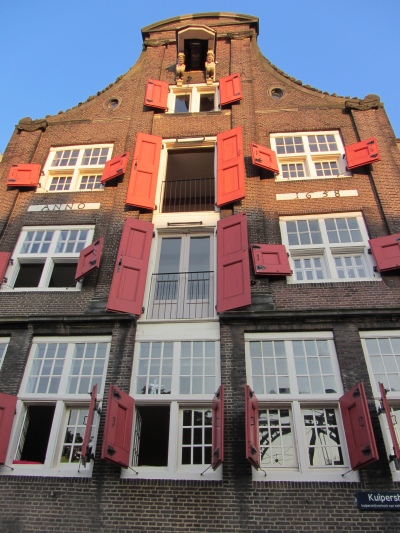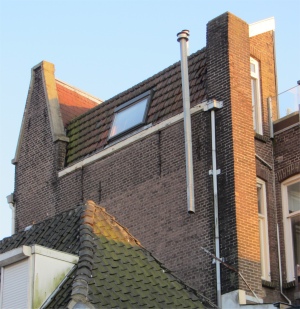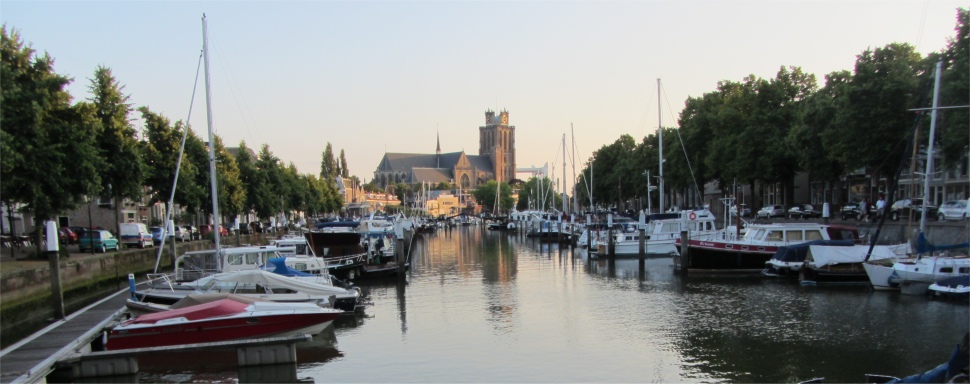 Dordrecht Road and Rail Bridges |
After fixing the bow navigational lights, I nipped off smartly to the bakers and supermarket. The bakers was no problem: some tasty dark bread that Meryl adored, a loaf of white, and some currant rolls. The supermarket, however, did not open until 08:30. The woman who waited patiently alongside me protested that she dropped her children off to school at 08:15, and couldn't get her shopping done until 08:30. I guess she was anxious to get back home to have it all scrubbed and polished by noon.
Once we had cleared breakfast away and were ready to depart, Rex informed me that I would be taking the boat out of the marina. Gulp! I managed to ease us out without damage to man or property, and soon we were heading up the Hollands Diep. Since the weekend was over, the number of leisure craft on the water had dropped dramatically, but the large barges still ploughed on.
 Brocante (Flea Market) |
The southern approach to Dordrecht was heavily industrialised. The Dordtsche Kil merged into the Oude Maas, and to reach the city marinas, we would need to pass under a road bridge and an adjacent rail bridge. These bridges only opened at two hourly intervals, so we needed to kill time for an hour. Luckily, a small pontoon existed on the other side of Duivelseiland (Devil's Island), an island just before the two bridges, reached by performing a right-hand switchback. Rex, Alan and I had used this pontoon three years earlier on our way to St Petersburg. We joined a Dutch boat on the pontoon, owned by a couple who were returning home to Kinderlijk. I quizzed the chap about sailing in the Biesbosch, and he endorsed everybody else's opinions, "The channels are very narrow and shallow and it is highly likely that you would run aground. You would require very detailed charts and a special licence. It is not advisable, particularly if your keeled boat has a fair draft."
 Public Library |
 Johan and Cornelis De Witt |
Once well ensconced in this tidal marina (yes, this far inland and it was tidal), we headed off into town to locate the VVV (Tourist Information Centre), admiring the giraffe that was shading under some trees by the marina. One of the streets we wandered down was an antique collector's paradise, full of brocantes. A while back, Yvonne, the Dutch wife of the salting's marine engineer, had explained to Rex and Meryl that the Dutch used to call flea-markets by their English name "flea-markets". They then decided the French equivalent "brocante" sounded better, and took it on board. Apparently the Dutch are very willing to adopt words from other languages. Rex and Meryl were in raptures as they strolled past these junk shops, gazing through the windows. I was more interested in finding art shops to gaze into.
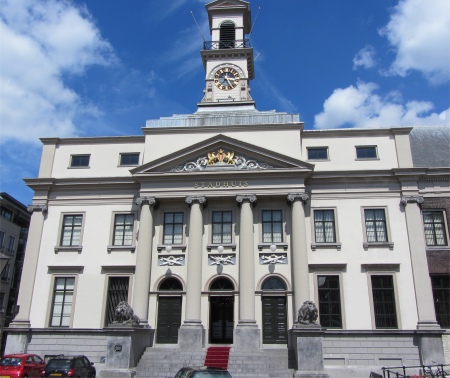 Stadhuis |
 Painting Hanging by Lombardbrug Waterway |
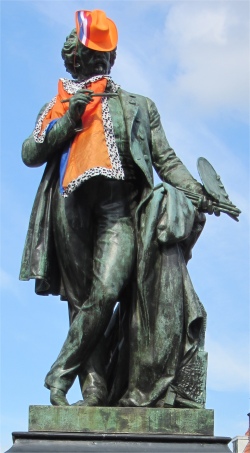 Arij Scheffer Supporting the Dutch |
The VVV was in a canal side setting on the Spuiboulevard, and located in an impressive, modern building. It contained all the information on the city and environs that we could wish for. The helpful staff explained how we could get out to the Biesbosch, and Rex managed to get charts for the Beneden Merwede waterway up to Gorinchem, a possibility for later in the week.
A leisurely meander through the busy city took us past a plethora of shops common to most cities. A break for a refreshing drink in Scheffersplein was most welcome, and provided yet another opportunity for Rex to excel in his linguistic expertise. The square was full of tables, an "eating" square, and on the periphery, all the bars and restaurants were bedecked with orange bunting for the World Cup. Large video screens abounded. The Netherlands were playing at 6pm, and the excitement and anticipation were tangible. Even the statue of Scheffer, which dominated the centre of the square, had been given an orange makeover.
Arij Scheffer (1795-1858) was born in Dordrecht and became a famous romantic painter in Paris. Another Dordrecht artist was Aelbert Cuyp (1620-1691). This world famous landscape artist lived and worked for his entire life in Dordrecht. Besides these well-known artists, probably Dordrecht's greatest claim to fame is the fact that it is the oldest city in the Netherlands, and is located on an island.
Almost a thousand years ago, the first inhabitants of Dordrecht came to live in the water-rich area on the banks of the Thuredrith river. The favourable location at an intersection of trade routes, mainly over water, accelerated the development of the city. In 1220, the count of Holland bestowed city rights on a residential area for the first time. This was Dordrecht, the first city of the Netherlands.
Dordrecht received more privileges. The most important was the "stapelrecht" (staple rights). All traders that transported goods over the water were obliged to store and trade them in Dordrecht. The city grew, first along the raised embankments of the river Thuredrith, which is now the Voorstraatshaven. Later, warehouses and merchant's houses were built on the sandbanks outside of the city. Here, the Nieuwe Haven and the Wolwevershaven were created. The city became prosperous and influential.
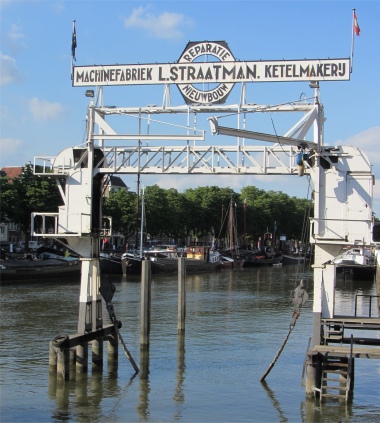 Straatman Dock on Wolwevershaven |
The water brought not only prosperity, it also regularly caused problems: floods and burst dykes. In 1421, disaster struck. The St. Elisabeth flood caused extensive flooding around Dordrecht. Some of this area was later reclaimed and enclosed by dykes, a large area developed into the Biesbosch. The forces of nature changed the landscape forever, but the city was spared. Trade steadily recovered and attracted merchants and craftsmen from Germany, Flanders and England.
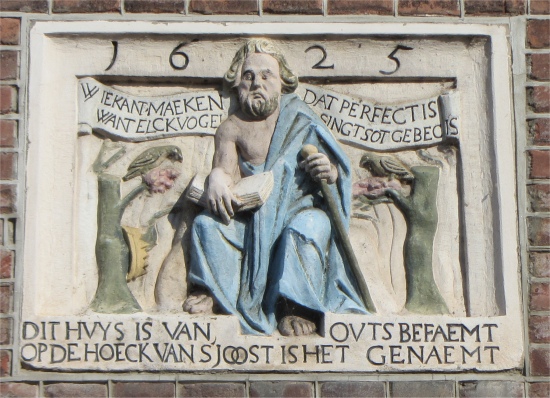 Just One of Many Such Plaques |
The Synod of Dordrecht was held in 1618/9 to put an end to the religious disputes within the protestant church. The results of this important national synod were the Dordrecht principles set forth the Reformed doctrine on the following points: total depravity, unconditional election, limited atonement (arguing that Christ's atoning work was intended only for the elect and not for the rest of the world), irresistible (or irrevocable) grace, and the perseverance of the saints. In addition an order was issued to make the first Dutch translation of the bible. This became the Statenbijbel (State Bible) of 1637. The Synod and the authorised translation of the bible have greatly influenced the ecclesiastical and cultural history of the Netherlands and the Dutch language.
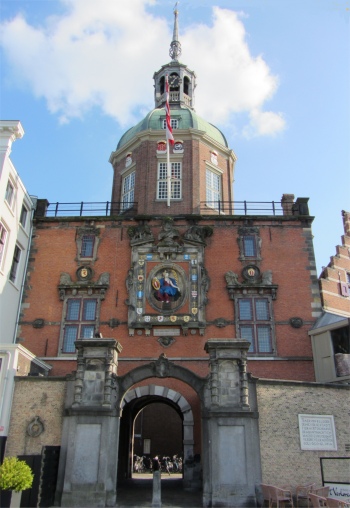 Groothoofdspoort |
 Dordrecht Maiden Sitting in the "Garden of Holland" |
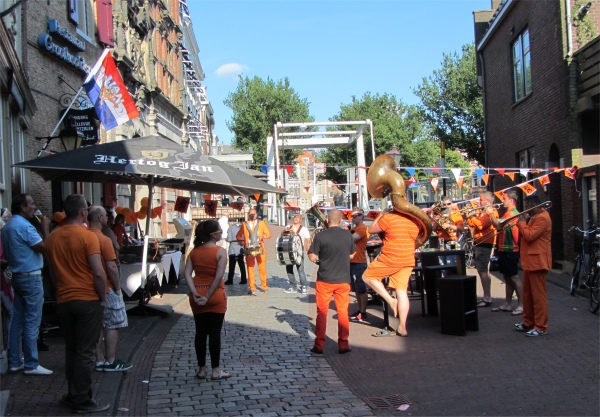 Half-time Celebrations |
In the evening we walked up by the Nieuwe Haven and Wolwevershaven, stopping to ponder on past times at the Straatman Dock, before arriving at the Groothoofd, which offered a commanding view of the three waterways that met here. The rivers Oude Maas, Beneden Merwede and Noorde converged at this point in Dordrecht, at Europe's busiest river confluence. In the past, the waterfront here was the most important mooring for ships. Dominating this front was the Groothoofdspoort gate, providing access to the inner city. This main city gate together with the Grote Kerk defined the skyline of the city from the water.
Although initial work began on designing the building in 14th century, the main part of the structure was not completed until the early 15th century. The gothic details which are visible were common architectural features of the time; however this made them no less stunning, especially when you consider that few buildings from this period have survived. The tower was added later in 1618. The relief on the front of the structure showed the Dordrecht maiden sitting in the "Garden of Holland". In her left hand she held a palm branch and in her right she held the city shield of Dordrecht. Underneath the relief, there was an inscription in Latin, which read "Unity and Peace are the best defence for a city. May my God protect me". Around the maiden, the city shields of 15 other Dutch cities were arranged. Starting in the top right hand corner (the monk), you can see the shields of: Monnickendam, Enkhuizen, Asperen, Heusden, Schiedam, Vlaardingen, Geertruidenberg, Schoonhoven, Hoorn, Weesp, Leerdam, Naarden, Muiden, Medemblik and Grootebroek. These were 16 of the cities which were integral to the rebellion during the Eighty Years War, which led to the eventual secession of the Dutch republic. On the opposite side of the tower there was another relief, which showed the Dordrecht crest, held by two griffins.


